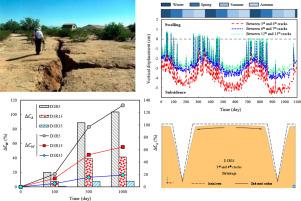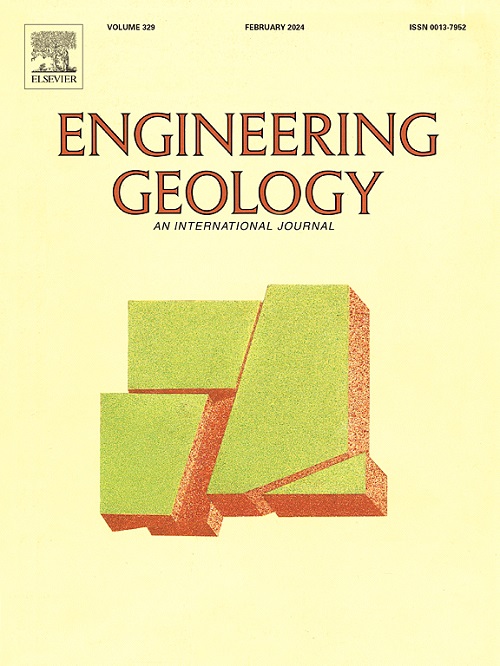Thermo-hydro-mechanical modelling of the heterogeneous subsidence and swelling in the desiccation cracked clayey strata
IF 6.9
1区 工程技术
Q1 ENGINEERING, GEOLOGICAL
引用次数: 0
Abstract
Soil desiccation cracking as a consequence of severe environmental changes alters soil deformation mechanisms significantly. Therefore, this study aims to explore the effect of crack characteristics and environmental conditions on the heterogeneous deformation of desiccation-cracked soils using thermo-hydro-mechanical analyses. The model framework consists of balance equations, thermal, hydraulic, and mechanical constitutive equations, while the model scenarios were determined based on statistical analyses. The meteorological record of Qom city was used for three years, from 2015 to 2017, to capture long-term behaviour under wetting-drying cycles. Findings revealed that cracks extend the deformation range, potentially up to six times, with variation based on crack dimensions and spacing. Notably, narrower cracks experienced more pronounced deformation than wider ones. The cracked soil with a crack depth of 2.5 m showed 1.5 times higher swelling and subsidence than crack depth of 1 m. Furthermore, the wider cracks indicated a lower rate of increase in their dimensions compared to the initial state during drying. The investigation also highlights the mechanisms of soil surface shape due to swelling and shrinkage, resulting in concave and convex surfaces, respectively. The results provide new perspectives on the behaviour of fine-grained deposits in arid to semi-arid climates with deep groundwater levels.

干燥开裂粘土地层中异质沉降和膨胀的热工水力力学模型
土壤干燥开裂是严重环境变化的结果,会显著改变土壤的变形机制。因此,本研究旨在通过热-水-机械分析,探讨裂缝特征和环境条件对干燥开裂土壤异质变形的影响。模型框架由平衡方程、热力、水力和力学构成方程组成,模型情景则根据统计分析确定。库姆市从 2015 年到 2017 年三年的气象记录用于捕捉湿润-干燥周期下的长期行为。研究结果表明,裂缝扩大了变形范围,可能高达六倍,并根据裂缝尺寸和间距而变化。值得注意的是,较窄的裂缝比较宽的裂缝经历了更明显的变形。此外,与干燥时的初始状态相比,较宽的裂缝显示出较低的尺寸增加率。调查还强调了土壤表面形状的形成机制,即膨胀和收缩分别导致凹面和凸面。这些结果为地下水位较深的干旱至半干旱气候条件下细粒沉积物的行为提供了新的视角。
本文章由计算机程序翻译,如有差异,请以英文原文为准。
求助全文
约1分钟内获得全文
求助全文
来源期刊

Engineering Geology
地学-地球科学综合
CiteScore
13.70
自引率
12.20%
发文量
327
审稿时长
5.6 months
期刊介绍:
Engineering Geology, an international interdisciplinary journal, serves as a bridge between earth sciences and engineering, focusing on geological and geotechnical engineering. It welcomes studies with relevance to engineering, environmental concerns, and safety, catering to engineering geologists with backgrounds in geology or civil/mining engineering. Topics include applied geomorphology, structural geology, geophysics, geochemistry, environmental geology, hydrogeology, land use planning, natural hazards, remote sensing, soil and rock mechanics, and applied geotechnical engineering. The journal provides a platform for research at the intersection of geology and engineering disciplines.
 求助内容:
求助内容: 应助结果提醒方式:
应助结果提醒方式:


